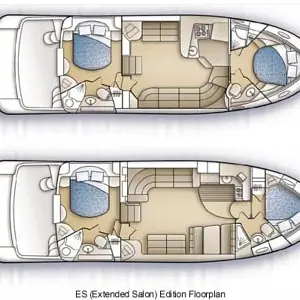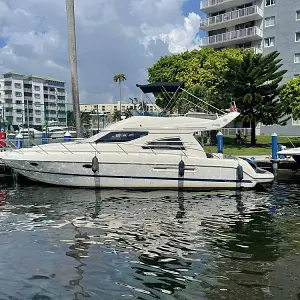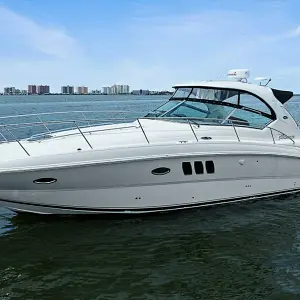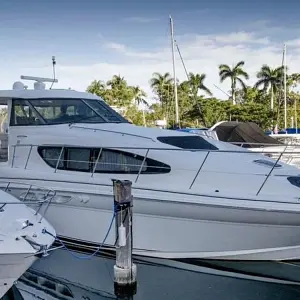The first of an iconic line of superb and sought after yawls and ketches designed and built from the late 1950s through the mid 1970s by McGruers of Clynder, Scotland, SULE SKERRY may well be the purest to their roots: the beamy Cruising Club of America cruiser racer yawls of the 1950s.The first of an iconic line of superb and sought after yawls and ketches designed and built from the late 1950s through the mid 1970s by McGruers of Clynder, Scotland, SULE SKERRY may well be the purest to their roots: the beamy Cruising Club of America cruiser racer yawls of the 1950s. First impressions on stepping aboard are of the elegantly purposeful air of a classic yacht that just feels right: airy, roomy and comfortable by modern standards; well found, undoubtedly seakindly by reputation - with fleetness of foot taken for granted. An impressive maintenance and upgrading regime under present ownership leaves SULE SKERRY immediately ready for more of the extensive passagemaking and family cruising adventures for which she is famous.
I have owned SULE SKERRY for 16 years, initially in partnership and since 2016 in sole ownership. During this time, we have undertaken the extensive winter restoration works detailed below while enjoying sailing her by summer. For the past quarter century she has spent each winter in a shed at Silvers Marine, Rosneath. Sailing under my ownership has been cruising in her home territory of the Clyde and the West Coast of Scotland with forays up to Orkney and Ireland. She has participated in local Classic Boat regattas, where she has acquitted herself honourably. We have not raced her seriously, though informed opinion suggests that she is the fastest of the four McGruer 43 foot yawls and I am sure that, brought up to racing trim, she would perform well. SULE SKERRY has been a delight to own and sail. She is well-mannered and without vice, has an easy motion in a seaway and is comfortable and roomy below. As well as being able to stand up to her canvas, she is remarkably “slippy” in light airs. I have enjoyed and learnt from participating in the winter boat work nearly as much as the sailing of her. Sadly, advancing years suggests that now is the time to start the process of looking for a new steward who will continue to care for her. The restoration of an old lady like SULE SKERRY is a journey not a destination, but I am confident that I will be handing her on to her next owner in good condition.
Major works, excluding routine painting and varnishing. The large majority of the work was carried out by experienced boatbuilder Chris Ings assisted by the owner:New smoked glass tops to hatches and dorade boxesPartial replacement of port covering board, sheerstrake and toerail - Repairs to port beam shelf - Using teak salvaged from the clipper ship, CUTTY SARKRemoval, refurbishment, re-bolting of final 5 steel floors under cabin sole - Replacement or repair of affected planks as required - Replaced cabin sole bearers - Re-chroming of window bezels and replacement of glass where needed - Running rigging replaced including new mainsheet trackRefurbishment of main mast-step and associated floors - Associated frame and planking replacement as needed - Replacement of two forward ballast keel bolts - Upgrade of heads with new sea toilet and Corian basin - Replacement of all standing rigging - Replacement of mizzen mast chainplates - Fitting of new Andersen winches (ST52 and ST40) - Installation of B&G autopilot, VHF, nav electronics and mast lights - New cookerReplacement of main mast chainplatesNew Betamarine 43 diesel engine on new bearers - (Replacing her 2nd Mercedes OM36) - Removal, refurbishment and rebolting 10 x steel floors under engine - Replacement or repair of affected planks as requiredMinor collision repair (caused by an out of control Gareloch O.D. at home mooring - Refurbishment of 8 x wrought-iron floors under cabin soleReplacement of cushions and mattresses - Deck re-caulkingNew main boom by Freeland Yacht Spars (boat's 50th Birthday presentNew Sprayhood, covers for sails and hatches etc - Counter repair (Silvers) - Refurbishment of 4 x floors in forepeak
MCGRUER & CO LTD Yard No. 588 Recalling his father, Lt Col John Cameron, commissioning this superb 43ft yawl from McGruer & Co during the winter of 1957-58, Neil Cameron says: "A wet holiday on the west coast in 1957 led to something of an ultimatum from my mother - a dry boat or no more family cruises!" John Cameron liked the look of the beamy by European standards 43ft Sparkman & Stephens centreboard yawl FAIRWYN already under construction by McGruers that winter and asked James McGruer for something similar with a full keel. SULE SKERRY was ordered 1st December 1957 at £13,750 plus extras for delivery 1st August 1958 at the latest - and was launched into the Gareloch on 9th July. Sails were by Mackenzie of Sandbank and auxiliary power from a Meadows 'Kittiwake' 4-cylinder 22hp petrol motor. SULE SKERRY was to be the first of an iconic class of 43ft fast cruising yawls by McGruers (SULE SKERRY, WESTWARD OF CLYNDER, MARGUERITA HELENA III/ FRENESI and COIGACH) from a time when the demands of building to Sparkman & Stephens' exacting specifications would set new standards in UK yachtbuilding by the Clynder yard that were rarely matched elsewhere. The Cameron's previous yacht had been the lovely Alfred Mylne/ Dickies of Tarbert double-ender yawl SKERRYVORE, named after the Lighthouse Stevenson's dramatically remote, reef-based lighthouse south west of the Isle of Tiree. Perhaps anticipating the greater cruising horizons from home waters on the Firth of Clyde that such a capable and comfortable yacht would afford, the name for his next boat followed the theme: Sule Skerry light is about 50 miles west of ORKNEY in the North Atlantic. The Camerons would indeed sail SULE SKERRY extensively for nine seasons, with summer cruises on the west coast of Scotland, the east coast of Ireland, Norway, Denmark, Sweden and Brittany. In 1967 her home port changed to Howth, north of Dublin, Ireland, under the ownership of John and Jennifer Guinness, although Lloyd's Register of Yachts in 1967 and 1968 first recorded her owner as John's brother, Peter. In the Guinness tradition, SULE SKERRY was painted green, and she was sailed back to McGruers to receive a laid teak deck over the original painted plywood one. Her cruising range was extended south in 1970 to the Azores, and during a 1974 cruise to Norway, the Guinnesses visited Sule Skerry light. Jennifer Guinness recorded the event amusingly in that year's Irish Cruising Club Annual: "It was quite clear from conversations overheard on the R/T between the lighthouse keepers on Sule Skerry and other Northern Lighthouse stations that they viewed the impending visit from a yacht whose owner wanted some bits of rock from the island as a perfect example of the lunacy of mankind in general and yachtsmen in particular. John and Davy went ashore at Sule Skerry on 2 July at 10:00 while Mary and I sailed around as there was too much swell to anchor comfortably. They were welcomed by the keepers who were most helpful and showed them around the station. The island is about ¾ mile long and not more than 50 feet high so the vegetation is sparse. We were fortunate to have made our visit this year as soon the light will be automated and the rock will become unmanned." In 1975 SULE SKERRY's third owner, Irish Cruising Club, Royal Ulster and Strangford Lough Yacht Clubs member Gilbert O'Connor, moved her home mooring north to Strangford Lough, and her relatively ambitious summer cruises continued, including in 1981 to Brittany in search of good seafood. The following year she was sold to Michael Ainslie, father of Ben Ainslie, the Olympic Medal winner and America's Cup helmsman. SULE SKERRY features in (now Sir) Ben's autobiography “Close to the Wind” with photographs of the young Ben learning to sail. The sad ending to this period of ownership is also described in the book. The family were unfortunate to get a pot-buoy rope around the prop and with sails still up encountered rocks at the entrance to the Helford river. The boat sank, fortunately without injury or loss of life. SULE SKERRY was then slowly and partially repaired under the ownership of Charles Law, with the process of fully returning her to the manner born accelerated from 1995 by Gordon Milloy and Frank Halford who returned her to McGruers for completion of the repairs. The present owner purchased SULE SKERRY with a McGruer enthusiast partner in 2006 and since then the process of lavishing just deserts on her each winter has been impressive, and detailed elsewhere here. SULE SKERRY is a very happy ship. ©2024 Iain McAllister/ Sandeman Yacht Company Ltd.
Built under Lloyds supervision to 100A1 Classification - Double planked African mahogany: 5/16” inner and 3/4” outer - Bronze screw fastened - Oak centreline oak - Laminated mahogany main frames - 2 Steamed oak timbers between - Galvanised steel plate angle floors at main frames - Galvanised wrought iron floors at timbers for bent frames - Galvanised bolts for floors and 4.25 tons lead keel - Teak laid deck on plywood - Mahogany deck carpentry - Teak toe-rails and covering boards
FROM AFT AFT DECK - Stainless steel pushpit with mizzen sheet anchor point - Stainless steel stanchions and guard wires forward to pulpit - Chromed mooring fairleads and chafe strips port and starboard - Chromed and teak mooring cleats port and starboard - Spare aft chainplate - Split main backstay chainplates - Mizzen chainplates - Mahogany lazarette hatch - Mahogany 4.5 kg Calor gas bottle locker - Eberspacher deck-mounted exhaust - Mizzen mast position - 2 x Stainless steel mushroom vents - Padeye mounted sheet lead blocks port and starboard COCKPIT - Sweetly curved raised and capped mahogany coaming - Substantial mainsheet track effectively creates helm cockpit - Whitlock helm pedestal with binnacle - Selden mainsheet track - Sheet tails bag under - Deep lift-deck stowage lockers port and starboard - Stowage for mooring lines, fenders, dinghy, outboard motor, buckets - 2 x Andersen ST52 sheet winches - 2 x Anderson ST40 secondary winches TRUNK CABIN - Varnished mahogany sides - Painted plywood roof - 2 x Large aft windows & 4 x ports port lights and starboard - 1 x Eliptical port light forward - Teak grabrails port and starboard - Companionway sliding hatch in teak laid garage - Moulded sprayhood base - Mahogany / smoked perspex saloon skylight hatch - 2 x Dorade vent boxes with plastic cowls - Main mast position - Liferaft stowage chocks - Boathook stowage to port - Jockey pole stowage to starboard - Mahogany / smoked perspex forecabin skylight hatch - 1 x Dorade vent box with stainless steel cowl SIDE DECKS - Toerail mounted Lewmar foresail sheet tracks - In-period Tufnol blocks - Spinnaker pole stowage to starboard - Chromed and teak bar mooring cleats port and starboard FOREDECK - Duerr Torkmaster hydraulic anchor windlass - 2 x Chain gypsies; 1 x warping drum - Supplied by hydraulic pump - Belt driven with electromagnetic clutch by engine - The original 45lb CQR main anchor - 25lb CQR kedge anchor - Danforth pattern available not used in current ownership - Chromed and teak mooring cleats port and starboard - Storm jib forestay padeye - Chromed toerail inset mooring fairleads port and starboard - Stainles steel stemhead: 2 x bow rollers; forestay and pulpit anchor fittings - Stainless steel pulpit
- Varnished mahogany furniture - White painted surfaces - Trunk carlin moulding fashioned to grabrail throughout length - Varnished mahogany hull-side slatting throughout - Accommodation for max 7, but comfortable 5 - 12 V Strip lighting in aft accommodation and saloon - Original 12 V (with LED) reading lights in forecabin FROM AFT - 1 x then 3 x steps down companionway - Engine space aft of ladder GALLEY TO PORT - Bainbridge Neptune 4500 2 x burner cooker with oven and grill - Cooker crash bar - Plates racks outboard - Stowage/ lockers outboard and under - Athwartships stainless steel sink - Pressurised cold-water via Jabsco pump - Whale manual fresh water pump - Whale manual salt water pump - Stowage/ lockers under and over NAV AREA & QUARTER BERTH TO STARBOARD - Chart table; stowage under - A cushion extends the quarter berth over the chart table - Ship's electrical panel - Oilskin locker athwartships - Navigator's seat FORWARD TO SALOON - Traditional American arrangement - Settees port and starboard with pilot berths outboard - Port settee is 'L' shaped - Copious stowage lockers under and outboard settees - Lockers at fwd end of both pilot berths w. fold down tables - Drop leaf mahogany gimballed saloon table - Sideboard starboard fwd with lockers under and outboard FORWARD TO PASSAGE - Hanging locker to starboard - WC compartment to port - Lickers outboard - Johnson Aqua T compact manual flush toilet - Corian surface and basin - Lockers under - Pressurised cold-water via Jabsco pump FWD TO FORECABIN VIA ATHWARTSHIPS SLIDING DOOR - Hanging locker to starboard - 2 x V-berths - Shelving outboard - Stowage under - Removable slatted panel to forepeak/ chain locker - Folding mast steps access to forehatch exit
RIG - Original Sitka spruce masts and mizzen boom - Freeland Sitka spruce main boomEd Burnett-designed chromed worm drive main outhaul - Andersen 10 winch at main boom for reefing pennants - Main halyard original patent wire winch - Barlow foresail halyard winch - Original Tufnol mizzen halyard winch - Standing rigging new 2017 - Alloy spinnaker pole - Alloy jockey pole - Profurl Classic foresail furler - Selden blocks and main track for main and mizzen SAILS - Mainsail - Nicolson HughesTop two battens full length - Mizzen - Nicolson Hughes - Small jib - Lightweight genoa - Storm jib - fitted to removable inner forestay (2010 unused) - Mizzen Staysail - Spinnaker CANVASWORK - Beige sprayhood - Beige canvas covers for sails, hatches and winches
MECHANICAL - Betamarine 43hp Diesel - Traditional drive train to 17” Maxprop - Whitlock chain and cable steering gear linked to rudder quadrant HYDRAULIC - Engine-driven pump for windlass HEATER - Eberspacher D2 Compact; outlets saloon, forecabin and heads ELECTRICAL - 3 x 100 Ah batteries (1 x dedicated starter battery; 2 x house) - ADVERC battery management system - ADVERC voltmeter - 220 V Shore power system - Modern Sterling multistage charger when connected to shore power TANKAGE - Stainless steel diesel tank; approx 120 L; under cockpit sole - 2 x connected stainless steel freshwater tanks under cabin sole
NAVIGATION B & G Instruments - Triton linked to 2 x Airmar depth/ log sensors, one each side of keel - Linked by Tinley Tack Cos changeover switch - Masthead wind-sensor - Vulcan 7 chart plotter on cabin top - Triton displays at cockpit and navigation station - Plastimo binnacle mounted steering compass B&G HYDRAULIC RAM AUTOHELM - Linked to rudder quadrant - Control at cockpit bulkhead - Wireless remote control COMMUNICATIONS - B&G 500 VHF with AIS receiver - Linked handset for cockpit use - Cobra portable VHF
- 1 x Whale manual bilge pump operated from cockpit - 1 x Whale electric bilge pump with automatic function - Ocean Safety 4-Person LiferaftLifesling valise - Horseshoe lifebuoy - Gas detector - CO alarm - Original bronze emergency tiller - Navigation lights at stem and stern and steaming light on mast
- Original wooden Boathook - Original mahogany boarding ladder - Mooring lines - Fenders - Aquafax XL 2.6 inflatable dinghy - Honda 2HP 4-stroke air-cooled outboard
Sailing: Kathy Mansfield Launch: Peter Leddy, Dumbarton, c/o Neil Cameron Kyles of Bute 1960s: Iain Smith At Sule Skerry: John & Jennifer Guinness/ Irish Cruising Club Annual 1974 Ben Ainslie: From his autobiography, "Close to the Wind"








